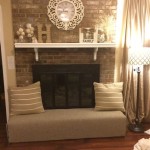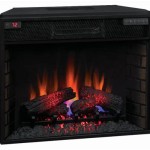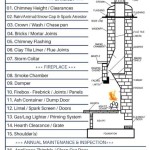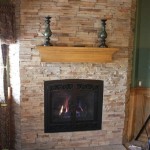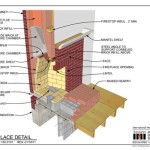Tiling Over a Brick Fireplace: A Comprehensive Guide
Tiling over a brick fireplace can transform its aesthetic, offering a modern update or a complete style overhaul. While brick fireplaces possess a certain rustic charm, they may not always align with the desired interior design of a living space. Tiling presents a versatile solution, allowing for a wide range of colors, patterns, and textures to be introduced, significantly altering the fireplace's visual appeal and the overall room ambiance. However, proper preparation, suitable material selection, and meticulous installation are crucial for a successful and long-lasting tiling project.
This article aims to provide a detailed guide to tiling over a brick fireplace, covering the necessary steps from initial assessment to final grouting. It will address the challenges inherent in working with brick surfaces and offer practical advice on overcoming them. The information provided is intended for homeowners with basic DIY skills, as well as for professional tilers seeking a refresher on best practices.
Assessing the Brick Fireplace and Planning the Tile Design
The first step involves a thorough assessment of the existing brick fireplace. This includes examining the condition of the brick, identifying any loose or damaged bricks, and determining the overall surface level. Cracks, crumbling mortar, or uneven surfaces need to be addressed before tiling can commence. Neglecting these issues can compromise the adhesion of the tile and lead to premature failure of the installation. If significant structural damage is present, consulting a professional mason is recommended.
Following the condition assessment, the next crucial step is planning the tile design. This involves selecting the type of tile, its size, pattern, and color. The design should complement the existing décor of the room and align with the desired style. Factors to consider include the overall scale of the fireplace, the size of the room, and the amount of natural light available. Smaller tiles can create intricate patterns and add visual interest, while larger tiles can offer a more modern and streamlined appearance. Choosing the correct tile adhesive is also important. This should be heat resistant and suitable for use on brick surfaces.
Accurate measurements are essential for calculating the amount of tile required. It is always advisable to purchase slightly more tile than needed to account for cuts, breakage, and future repairs. A detailed layout of the tile pattern should be planned on paper before starting the installation. This will help to visualize the final result and identify any potential issues with tile placement. Consider the grout lines as part of the overall design, as the grout color can significantly impact the final appearance of the tiled fireplace.
Preparing the Brick Surface for Tiling
Proper surface preparation is paramount for ensuring a strong and durable bond between the tile and the brick. This involves several key steps, starting with cleaning the brick surface thoroughly. Remove any dust, dirt, soot, or grease using a stiff brush and a suitable cleaning solution. A solution of trisodium phosphate (TSP) can be effective for removing stubborn stains, but it is crucial to follow the manufacturer's instructions and wear appropriate safety gear, including gloves and eye protection. Rinse the surface thoroughly with clean water and allow it to dry completely.
Once the brick is clean, address any loose or damaged bricks. Remove any loose bricks and re-mortar them in place using a high-quality mortar mix. Ensure the mortar is flush with the surrounding bricks and allow it to cure completely before proceeding. Fill any cracks or holes in the brick with patching compound, following the manufacturer's instructions. Sand the patched areas smooth to create a level surface for tiling. If the brick surface is particularly uneven, consider applying a skim coat of thin-set mortar over the entire surface to create a more uniform base.
Applying a bonding agent or primer is highly recommended to improve the adhesion of the tile adhesive. A bonding agent will create a more porous surface, allowing the adhesive to grip more effectively. Choose a bonding agent specifically designed for use on brick surfaces and follow the manufacturer's instructions for application. Allow the bonding agent to dry completely before applying the tile adhesive. Some professionals recommend installing cement backer board over the brick for a smoother, flatter and more uniform surface before tiling. If this option is chosen, the cement board must be securely fastened to the brick using appropriate fasteners.
Installing the Tile on the Fireplace
With the brick surface properly prepared, the tile installation can begin. Start by applying a layer of thin-set mortar to the brick surface using a notched trowel. The size of the notches on the trowel will depend on the size and type of tile being used. Follow the manufacturer's recommendations for the appropriate trowel size. Apply the mortar in small sections, working from the bottom up. This will prevent the tiles from sliding down the wall before the mortar has had a chance to set.
Carefully place each tile onto the mortar bed, pressing firmly to ensure good contact. Use tile spacers to maintain consistent grout lines between the tiles. Check the level and alignment of each tile using a level and adjust as necessary. Wipe away any excess mortar from the tile surface with a damp sponge. Continue tiling until the entire fireplace surround is covered. Allow the mortar to cure completely according to the manufacturer's instructions, typically 24 to 48 hours.
Once the mortar has cured, remove the tile spacers. Prepare the grout according to the manufacturer's instructions. Apply the grout to the tile surface using a grout float, pressing it firmly into the grout lines. Remove any excess grout from the tile surface with a grout sponge, rinsing the sponge frequently in clean water. Allow the grout to dry slightly, and then buff the tile surface with a clean cloth to remove any remaining grout haze. Allow the grout to cure completely according to the manufacturer's instructions, typically 72 hours. Applying a grout sealer can help protect the grout from stains and moisture.
Selecting the Right Tile and Mortar for Fireplace Applications
Choosing the correct type of tile and mortar is critical for the longevity and safety of a tiled fireplace. Not all tiles are suitable for use around a fireplace, as they must be able to withstand the heat generated by the fire. Porcelain and ceramic tiles are generally good choices, as they are heat-resistant and durable. Natural stone tiles, such as granite or slate, can also be used, but it is important to choose a stone that is not porous, as porous stones can absorb moisture and crack when exposed to heat.
The mortar used to adhere the tile must also be heat-resistant. Ordinary thin-set mortar is not suitable for fireplace applications, as it can break down and crumble under high temperatures. Use a modified thin-set mortar specifically designed for use with heat-generating appliances. These mortars typically contain additives that increase their heat resistance and flexibility. Look for mortars that are rated for high-temperature environments, such as those used in ovens or kilns.
When selecting grout, choose a sanded grout for wider grout lines and an unsanded grout for narrow grout lines. Sanded grout contains fine particles of sand that add strength and durability to the grout. Ensure the grout is also heat-resistant and resistant to staining, as soot and smoke can easily stain grout around a fireplace. Consider using an epoxy grout, which is more resistant to stains and moisture than cement-based grout. Follow the manufacturer's instructions carefully when mixing and applying the grout.
Addressing Potential Challenges and Troubleshooting
Tiling over a brick fireplace can present several challenges, requiring careful planning and execution. One common challenge is dealing with uneven brick surfaces. As mentioned previously, applying a skim coat of thin-set mortar or installing cement backer board can help to create a more uniform base for tiling. Another challenge is ensuring proper ventilation behind the fireplace. If the fireplace is not properly ventilated, heat can build up and cause the tile to crack or delaminate.
Another potential issue is tile movement due to expansion and contraction caused by temperature fluctuations. To mitigate this, ensure that expansion joints are incorporated into the tile design. These joints allow for movement of the tile without putting stress on the surrounding tiles. Expansion joints should be placed along the edges of the tiled area and at regular intervals throughout the design.
If tiles start to come loose after installation, it is likely due to improper surface preparation or the use of an inappropriate adhesive. Carefully remove the loose tiles and clean the brick surface thoroughly. Apply a bonding agent and re-install the tiles using a heat-resistant thin-set mortar. Ensure that the tiles are firmly pressed into the mortar and that the mortar is allowed to cure completely before using the fireplace. If the problem persists, it may be necessary to consult a professional tiler to assess the underlying cause of the failure.

How To Tile Over A Brick Fireplace Curbly

How To Tile A Fireplace Even If It S Brick The Handyman Daughter

How To Tile A Fireplace Even If It S Brick The Handyman Daughter

How To Tile A Brick Fireplace Jenna Kate At Home

Renovating With A Tile Over Brick Fireplace Design

Renovating With A Tile Over Brick Fireplace Design
Mark S Tile Over Brick Fireplace Project Ceramic Advice Forums John Bridge

How To Tile Over A Brick Hearth Shine Your Light
Slate Tile Over A Painted Brick Fireplace Ceramic Advice Forums John Bridge
Tiling Over A Brick Fireplace Ceramic Tile Advice Forums John Bridge
Related Posts

